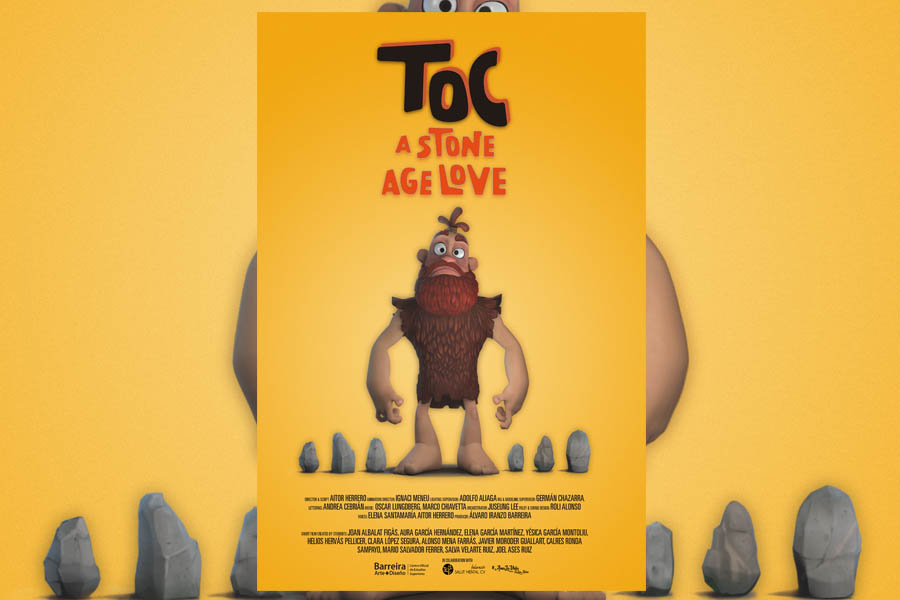ITA - Aitor Herrero dirige e scrive un cortometraggio d’animazione sul quale ha lavorato un grande team artistico, composto dagli alunni della scuola Barreira Arte y Diseño, coordinato da Ignaci Meneo per le animazioni, Adolfo Aliaga per l’illuminazione, Germán Chazarra per la modellazione. L’autore mette al centro del suo cortometraggio animato il disturbo ossessivo compulsivo, un tema originale tanto più se si pensa alla collocazione del cortometraggio, ambientato nell’età della pietra. L’opera è muta, salvo per le esclamazioni dei due protagonisti, ‘Toc’ e ‘Bum’, che corrispondono anche ai rispettivi nomi. Al di là di queste onomatopee, le interazioni dei personaggi, complice la collocazione temporale, sono affidate ai gesti e alla mimica, frutto di un’animazione accurata e tutta rivolta all’efficacia espressiva del linguaggio del corpo.
Toc è il protagonista, un uomo preistorico con un disturbo ossessivo compulsivo che lo porta ad assumere comportamenti insoliti, come allineare sassolini in fila indiana e ripulirsi il viso ogni qualvolta entra in contatto con un corpo esterno. Un giorno si imbatte in Bum, una donna dall’aria minacciosa che circola con una clava ma di cui Toc si invaghisce immediatamente. Dopo averla salvata dall’aggressione di un animale feroce, i due cominciano a legare e a convivere nella stessa grotta. I disturbi di Toc, tuttavia, creano un malinteso che rischia di mettere a repentaglio il suo legame con Bum. A Toc non resta che trovare un modo, il suo modo, per farle comprendere i suoi reali sentimenti.
Le musiche di Marco Chiavetta e Oscar Lundberg accompagnano le vicende rappresentate dal corto, sottolineando i cambi di atmosfera, in particolare i momenti comici e le risoluzioni felici che esplodono in uno scroscio di sonorità allegre. L’autore scrive il cortometraggio con sensibilità, aiutando lo spettatore non solo a provare empatia per l’adorabile protagonista dell’opera e per i disagi che interferiscono con alcuni aspetti della sua vita, ma rintraccia e mette in scena una strada attraverso la quale la diversità di Toc possa trovare la sua espressione e divenire, perciò, una risorsa e non un limite. Un modo tutto suo di stare al mondo e interagire con gli affetti.
La ripetizione, nel corto di Aitor Herrero, non è più semplicemente ossessione, ma è abbondanza, in questo caso di sentimenti. Ciò che rende strano Toc produce qualcosa di bello e lascia una traccia ancora oggi visibile, stando all’idea alla base del corto, a distanza di migliaia di anni.
______________________
ENG - Aitor Herrero directs and writes an animated short film on which a great artistic team, composed by the students of the Barreira Arte y Diseño school, has worked, coordinated by Ignaci Meneo for the animations, Adolfo Aliaga for the lighting, Germán Chazarra for the modeling. The author chooses obsessive-compulsive disorder as the topic of his animated short, an original subject even more when one thinks about the time period of the short film, set in the stone age. The work is mute, except for the protagonists’ exclamations, 'Toc' and 'Bum', which also correspond to their respective names. Aside these onomatopoeias, the interactions of the characters, even thanks to the temporal collocation, are entrusted to the gestures, the result of an accurate animation totally aimed to the expressive efficacy of the body language.
Toc is the main character of the short film, a prehistoric man with an obsessive-compulsive disorder that leads him to unusual behaviors, such as lining up small rocks in single file and wiping his face every time something touches him. One day he runs into Bum, a menacing-looking woman who circulates with a club but whom Toc immediately falls in love with. After saving her from the attack of a ferocious animal, they begin attached to each other and to live together in the same cave. Toc's disorder, however, creates a misunderstanding that threatens his bond with Bum. All that Toc has left to do is to find a way, his own way, to let her understand his real feelings.
The music by Marco Chiavetta and Oscar Lundberg accompanies the events represented by the short film, underlining the changes of atmosphere, in particular the funny moments and the happy solutions that explode in cheerful melodies. The author writes the short film with sensitivity, not only guiding the audience to feel empathy for the adorable protagonist of the work and for the discomforts that interfere with certain aspects of his life but tracing a way through which Toc’s diversity can find its expression and become a resource and not a limit. In other words, his own way of being in the world and interacting with his loved ones.
Repetition, in Aitor Herrero's short film, is no longer only an obsession, but it is abundance, in this case abundance of feelings. What makes Toc strange produces something beautiful and leaves a mark still visible today, according to the idea behind the short film, thousands of years later.















